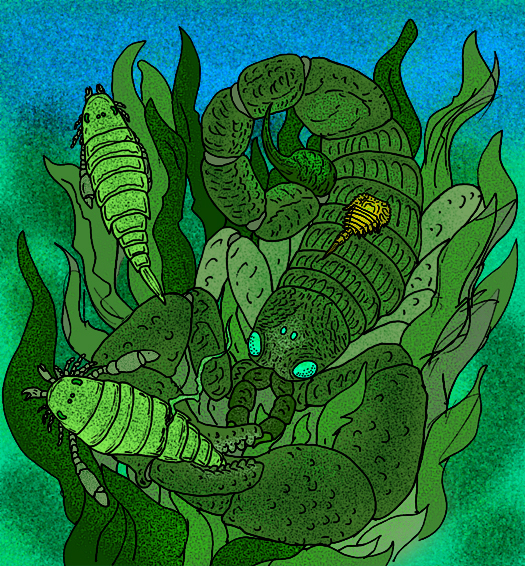- Brontoscorpio
fossil_range =Silurian
regnum =Animal ia
phylum =Arthropod a
subphylum = Chelicerata
classis =Arachnid a
ordo =Scorpion es
familia =Eoscorpiidae
genus = "Brontoscorpio"
binomial = "Brontoscorpio anglicus""Brontoscorpio anglicus" ("English thunder scorpion") was a 1-
metre long aquaticscorpion that lived during theSilurian period . When alive, "B. anglicus" would have resembled an oversized scorpion, albeit with relatively large (for a scorpion) compound eyes; it was an importantpredator of its time, given that thearthropod s were among the largest animals on Earth during the Silurian.uggested Ecology and Lifestyle
All post-
Paleozoic scorpions are terrestrial, while during the Silurian many of the known taxa made the transition from aquatic to terrestrial environments. It has been inferred that "Brontoscorpio" was capable of leaving the water and entering land, whether to evade other predators, such as large nautiloids, eurypterids, or even other aquatic scorpions; or pursue prey, such as other, smaller terrestrial scorpions Fact|date=April 2008. However, given its great size, "B. anglicus" had to return to the water when it tired of supporting its own weight, or at the very least whenever it moulted its exoskeleton (on land, it would risk being crushed by its own mass) Fact|date=April 2008. Marine scorpions such as "B. anglicus" captured, stung, and ate small sea animals such as fish likeacanthodian s,heterostracan s, smaller scorpions and trilobites Fact|date=April 2008.Anatomy
As with other
arachnid s, such as modern scorpions, "Brontoscorpio" respired through gas exchange via pores in its exoskeleton and the inner linings of itsbook lung s Fact|date=April 2008. Its tail was tipped with a large, venomous stinger that was, according to "Walking with Monsters ", the size of alight bulb Fact|date=April 2008.Popular Culture
"Brontoscorpio" was featured in the first episode of the
BBC TV seriesWalking With Monsters , where it is erroneously shown preying on the early armoured jawless fish "Cephalaspis ", only to be attacked and eaten, in turn, by the enormouseurypterid "Pterygotus ". Later, another group of these arthropods attack the migrating "Cephalaspis" as the jawless fish jump into their breeding pool. One "Brontoscorpio", however, has tomoult itsexoskeleton instead, even though (as was mentioned above) it's more likely that "Brontoscorpio" moulted its hard skin underwater instead.It is highly unlikely that "B. anglicus" preyed on "Cephalaspis", as the latter is found only in early
Devonian strata, and the former is found only in late Silurian strata. It is possible, however, that "B. anglicus" preyed on "Cephalaspis"' Silurian relatives, such as "Ateleaspis ", "Procephalaspis ", and "Tremataspis ".References
*Haines, Tim & Chambers, Paul. (2006)
The Complete Guide to Prehistoric Life . Canada: Firefly Books Ltd.
Wikimedia Foundation. 2010.

